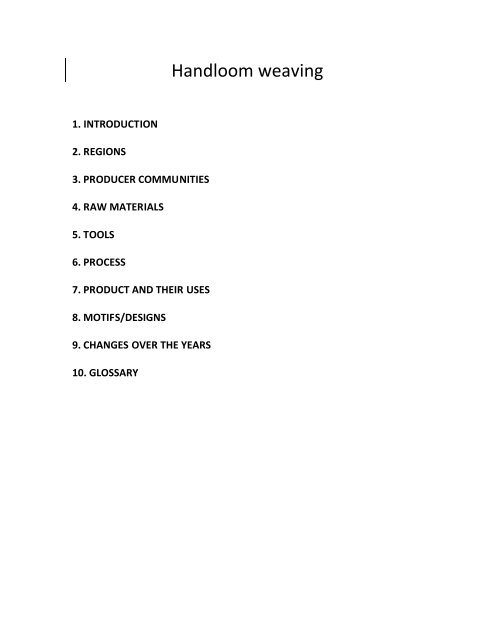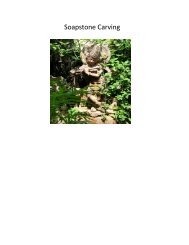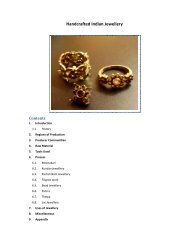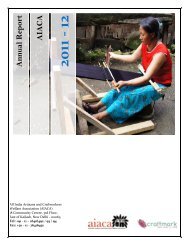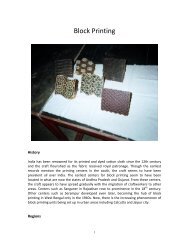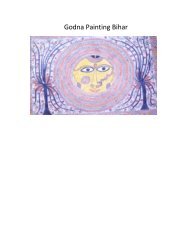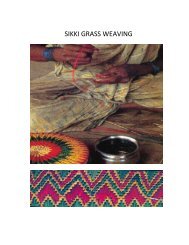Create successful ePaper yourself
Turn your PDF publications into a flip-book with our unique Google optimized e-Paper software.
1. INTRODUCTION<br />
2. REGIONS<br />
3. PRODUCER COMMUNITIES<br />
4. RAW MATERIALS<br />
5. TOOLS<br />
6. PROCESS<br />
7. PRODUCT AND THEIR USES<br />
8. MOTIFS/DESIGNS<br />
9. CHANGES OVER THE YEARS<br />
10. GLOSSARY<br />
<strong>Handloom</strong> <strong>weaving</strong>
1. Introduction<br />
The textiles of India are as diverse as its culture. Nearly four million handlooms are<br />
engaged in <strong>weaving</strong> fabrics of nearly 23 different varieties. The <strong>Handloom</strong> Census of<br />
India, undertaken in 1987-88, places the number of handloom textile workers at 65.3<br />
lakh persons, making them the single largest group of artisans in India. Providing direct<br />
and indirect employment to more than 30 lakh weavers, the handloom production is the<br />
largest economic activity second only to agriculture in India. <strong>Handloom</strong>s contribute<br />
nearly 23% of the total cloth produced in the country. During the year 1996-97, a total<br />
production of 7,235 million sq. meters of cloth was achieved. The <strong>Handloom</strong> Act passed<br />
by the parliament in 1985 aims to shield handloom weavers against power loom and<br />
textile mill operators by reserving certain textile articles (presently eleven in number)<br />
for exclusive production by handlooms.<br />
1.1 History<br />
India has one of the richest traditions in this creative activity - from Kashmir to<br />
Kanyakumari, Kuchch to Kohima. The <strong>weaving</strong> device - the loom - has been subject to<br />
constant hostile threats of being extinguished by the highly mechanized, organized,<br />
machinery-dominated textile industry for over a century and in recent decades, by the<br />
advent of the power loom. If the handloom has survived, it is because of its highly<br />
elastic range of adaptation in meeting communities’ needs and in its ability to produce<br />
exquisite fabrics which mills cannot produce in spite of all their sophisticated<br />
technologies.<br />
For centuries both the spinning and <strong>weaving</strong> processes were traditionally carried out by<br />
hand in the home on a cottage industry basis - <strong>weaving</strong> by men and spinning by women.<br />
Over a period of time to cater to market demand for most fabrics other than khadi, the<br />
spinning of yarn changed to a machine process. On the basis of this distinction,<br />
handloom fabrics can be broadly categorized in two types:<br />
i) Hand spun, hand woven: Khadi is hand spun and hand woven fabric<br />
ii) Machine spun, hand woven: All other handlooms fall under this category<br />
2. Regions
Weaving is practiced in many different regions in India. Each area has its own particular<br />
style, using traditional designs and motifs. Cotton is woven all over India. Apart from<br />
basic plain-weave fabric that is found in many places, one can take note of a few places<br />
for their distinctive weave. No matter how small or ordinary a weave may seem; it has<br />
its own distinctive character.<br />
The thousands of towns and villages where handlooms turn out huge quantities of<br />
material cater mainly to the common local people. The men need longish pieces of<br />
fabric to use as dhotis to wrap around the lower part of the body; durable material for<br />
jackets; a wrap on the body (chaddar) and lengths of fabric for the turban. This ranges<br />
from a rectangular piece to a two yards’ length, for turbans are found in countless types<br />
and offer an immense potential for ingenuity, style and taste. The women use large<br />
skirts, longish shirts, stoles or saris and blouses. Cloth is also woven for shirts, pajamas<br />
and children’s garments. All of these vary greatly from region to region. For instance<br />
while the lungi (sarong) is widely prevalent from north to south, it has many versions. In<br />
the extreme south only white lungis are worn. But starting from Andhra Pradesh right<br />
up to Punjab, brightly colored and intricately designed lungis can be seen.<br />
In countless villages and towns across the country, the sari continues to be the garment<br />
worn by the majority of women. Significant inroads have been made by machine made<br />
textiles. Yet the preference for traditional saris for ritual or every day use is one of the<br />
strongest reasons for the continued existence of a large proportion of the country’s<br />
handlooms.<br />
In Tamil Nadu and Andhra Pradesh, where inexpensive cotton saris are produced, even<br />
the simplest has a dignity lent by very broad borders on either side, or a single<br />
decorative touch of a heavily patterned pallu – the sari end which falls over the shoulder<br />
at the back. The distinguishing mark is what is known as korvari, the solid border where<br />
the weft threads of the field do not enter into the borders.<br />
Kerala has a distinctive sari type known as Karalkuda. Similar styles in color are also<br />
produced in Coimbatore and Madurai in Tamil Nadu, Chanderi in Madhya Pradesh, and<br />
Venkatagiri in Andhra Pradesh. This has a grand look with its sheer body and gold<br />
designs like dots, coins, leaves, parrots or simple geometrical patterns on the body.<br />
The Maheshwar sari, mostly in cotton is characterized by its simplicity yet with a few<br />
singular touches takes on an irresistible charm.
Another big center is Shahpur in Belgaum district, Karnataka state. While Maheshwaris<br />
are normally in bright colors, Shahpuris specialize in soft pastels or shots of two colors:<br />
one in the warp, another in the weft, with matching colors in the border and the pallu.<br />
Poona has its distinctive sari with a gold thread speckled panel for the pallu and a<br />
narrow gold patterned border.<br />
From Hubli-Dharwar to Bijapur in Karnataka state, cotton saris are made in dark earthy<br />
colors, which mark them out. There is a special sari in this area known as Irkal after the<br />
village in Bijapur district, from which it seems to have originated. Large quantities of<br />
yardage in the Irkali style are produced for blouses in a little village called Galedgudda<br />
near Irkal, and supplied to markets all over. Irkali style saris in finer counts are also<br />
made in Narayanpet in Andhra Pradesh. Irkalis are rich in their coloring with colors like<br />
the special pomegranate red, brilliant peacock blue, parrot green. The rasta design has<br />
horizontal lines in subtle matching colors running through the body of the sari with<br />
charming effect.<br />
Gadwal and Kothakota near Vanaparti in Andhra Pradesh weave fine cotton saris with<br />
rich gold borders and heavy panel-like pallus. Cotton saris with richly woven pallus and<br />
gold borders in opulent designs are made in places like Siddhipet and Armoor in Andhra<br />
Pradesh, which used to make them in silk. Now they also manufacture curtains,<br />
bedspreads, etc., using the old decorative motifs for ornamentation.<br />
Amongst elaborate styles in cotton <strong>weaving</strong> is Jamdani.<br />
Himroo is a kind of a brocaded material woven on a simple throw-shuttle loom on the<br />
principle of the extra weft figuring with cotton used in the warp and art silk in the weft.<br />
In this the preparation of the jala or design is most important for this is where initially<br />
the entire design is actually worked out, and prescribes where the extra weft silk yarn is<br />
to pass through some of the warp threads which is a most complicated and time<br />
consuming job.<br />
Mashru is also a similar material but lighter, woven in gentle parallel and diagonal lines<br />
intersecting each other or stripes. It has a glow, is popular for vests, blouses and scarves.<br />
Silk not only has a very ancient tradition, it enjoys also a significant status because of its<br />
use at rituals. This may partly account for the concentrated development of silk <strong>weaving</strong><br />
at popular places of worship like Varanasi and Kanchipuram. Varanasi is however in a<br />
class by itself not only for its superb <strong>weaving</strong> in gold and silver, but also for the very<br />
wide variety of techniques and styles its weavers can adopt. They are incomparable in<br />
their <strong>weaving</strong> talent and reproduce any antique museum piece with a distinction that<br />
would make anyone mistake the copy for the original.
The best-known Varanasi product is the brocade, kinkab. Half a pattern is worked by a<br />
combination of strings and healds manipulated separately. It is completed by reversing<br />
the order. Elaborate brocades are woven by combining this with double warps and<br />
border warps and with silk or metal thread. The weaver always has a helper to work<br />
alongside him. Brocades are varied, but the best and oldest are the beldar or scroll<br />
pattern, which appear in the Ajanta frescoes. The butidar design has stars and spangles<br />
scattered over the body. Some weaves are all gold without use of silk, with floral, mango<br />
or creeper designs. On larger pieces scenes with human and animal figures are<br />
sometimes woven in bands and lozenges. Some have a silver background with a<br />
superimposition of gold patterns. A very delicate and fascinating item is tissue in gold or<br />
silver - a shimmering cascade in brilliant metal. Varanasi saris are world famous and<br />
identified by spangles sprinkled all over the body, heavy gold border and pallu with a<br />
great variety of designs like floral sprigs, peacocks and cones in the corners. At times<br />
there are additional borders in tapestry weave separately woven and then attached.<br />
Varanasi has an old tradition in <strong>weaving</strong> special styles for export to specific countries of<br />
west and Southeast Asia, which naturally adds to the richness and variety of its<br />
products. These brocades are distinguished by apt poetic names like chand tara (moon<br />
and stars), dhup chhaon (sunshine - shade), mazch (Ripples of silver), mor gala<br />
(peacock’s neck), bulbul chasm (nightingale’s eyes).<br />
Gujarat developed its own style of kinkabs (brocades) woven with extra weft patterns.<br />
Surat as the chief port carried them far off: even to the Russian royalty. Kanbis or<br />
Patidars, Khatris and Mommin (particularly the women) are excellent in this weave.<br />
There are dozens of designs in vogue with a rather complicated constellation of animals,<br />
fruits, stylized dance figures, peacocks, women waving fans, and lotuses in many shapes.<br />
Rudrol in Mehsana district, Jamnagar and Dolka produce these brocades. . Here several<br />
varieties of silk like satin (Gajji) a lovely melting fabric, and mixtures like Mashru, are<br />
also made. A special item is the famous Nathwara pichwai in the brocade style.<br />
India has been famed from antiquity for filmy cottons patterned in gold. One sees<br />
startling weaves in these patterned cottons: a fine violet muslin with olive green border,<br />
and an all-over gold pattern in tapestry weave; a diaper design with cones at corners<br />
and an inner border of diagonal bands, and an ornamental twill weave with a gold<br />
lozenge pattern at the end. This would be a loom tapestry, gold threads having been<br />
inserted with tiny bobbins while <strong>weaving</strong>, and passed through and around the warp<br />
threads. Similarly long turbans and scarves in thin cotton are woven in single or double<br />
colors like rose and lemon with bands of golden yellow silk.<br />
Mubarakpur, also in Uttar Pradesh, is an important silk center, particularly for saris that<br />
mainly cater to the rural needs.
The Baluchar style woven in silk is only confined to saris. It hails originally from a place<br />
of the same name in Murshidabad district, West Bengal, and had its heyday under the<br />
patronage of the royalty and nobility. It later flourished in Vishnupur but is now<br />
successfully produced in Varanasi. Very colorful, a real traditional Baluchar is said to<br />
have 17 colors in it, with butis sprinkled all over. It is a plain-woven fabric brocaded with<br />
untwisted silk thread in unique designs. The saris are always in dark rich shades,<br />
particularly red, purpose, and chocolate. The simpler Baluchari has small dots or flowers<br />
all over with a flowery border and paisleys in the pallu.<br />
In Tanchoi saris the designs are always floral interspersed with bird motifs. The usual<br />
ground is bright blue, purple, green or red with areas patterned in tabby weave.<br />
Patola is a most colorful and ostentatious weave with its figured body, and the subtle<br />
merging of one shade into another. This technique is practiced in a few parts of India<br />
with some variations, mostly producing saris, a few shawls, lungis, kerchiefs, etc. The<br />
most renowned among patolas is the one made in Pattan, Gujarat. The yarn used is<br />
always silk.<br />
Ikat is the equivalent of the Indian bandhana. When only one side of the warp or the<br />
weft is tied, it is a single ikat. But as described above when both are tied it is double ikat.<br />
This is now done on a very small scale in Pattan, which is said to be its home, and in<br />
Rajkot. The Pattan patola is the most picturesque particularly the wedding sari with dark<br />
green, white and yellow, against a ruby red background, and leaf and flower patterns;<br />
while the pallu features dancing girls and parrots or swans.<br />
Orissa has a patola style of its own. The <strong>weaving</strong> is done in tussar silk and in single ikat.<br />
The designs usually are in floral patterns, with animals and certain traditional motifs like<br />
the fish and conch. The single ikat makes the designs suggestive rather than clearly<br />
delineated.<br />
The cotton ikats in Orissa are striking, with a firm accent on geometrical patterns in<br />
heavy weaves. Patolas are also woven in Pochampalli and Chirala in Andhra Pradesh,<br />
which originally did only large cotton kerchiefs called telia rumals. Pochampalli makes<br />
patola sarees in a large variety of geometrical designs. Chirala has bigger and more<br />
pronounced patterns in the same technique. Andhra Pradesh also weaves a great<br />
variety of cotton lungis with some ikat designs in the body or in the border.<br />
Named after the village Paithan in Maharashtra, is the Paithani sari. On a zari warp the<br />
weft is interlocked with different colors. In this technique complicated patterns are<br />
woven in bright colors: highly stylized flowers, swans, parrots, peacocks. The pallu is a
fascinating piece of gold tissue on which are woven brightly colored rosettes and<br />
sometimes birds.<br />
Assam leads in non-mulberry silk. Sericulture is an ancient vocation practiced by a large<br />
number of cultivators in non-agricultural seasons.. Assam has several varieties of silks:<br />
eri, which derives its name from the castor leaves on which the worm feeds. This silk has<br />
a yellowish tinge, is in rough as well as smooth varieties, and is used in winter for its<br />
warmth.<br />
Sualkuchi is the most famous center in Assam for silk weaves of delicate texture, dainty<br />
designs and delightful natural colors. Its specialty is the Assamese women’s dress like<br />
the mekhela. This is a woman’s lungi, mostly with plain body, but sometimes having<br />
motifs strewn over the fabric, with a heavy design at the ends. The chaddar and riha are<br />
in smaller lengths: the former going over the shoulder to provide a pallu, the other<br />
wrapped round the waist, both decorative.<br />
Kashmir too lays equal claim to antiquity in silk industry. Kashmir was amongst the<br />
earliest to export silk to West and Central Asia. Over the last thirty years, there has been<br />
introduction of modern silk fabrics here like crepe de chine, georgette, chiffon, etc. This<br />
area has become an important center for silks.<br />
South India is famous for its heavy quality silks. At one time silk fabrics were sold here<br />
by the weight, so heavy were the weaves. Tamil Nadu and Karnataka are notable areas<br />
for this type of silk. A village of Karnataka called Mokalmoru has a richly designed sari<br />
with all over motifs, each enclosed in a check. The border is done in ikat weave. The<br />
pallu is daintily decorated with birds, fishes, etc.<br />
In Tamil Nadu the pride of place goes to Kanchipuram, though Kollegal in Coimbatore<br />
district and Kumbakonam in Tanjore district, Salem and Arni, also have very fine<br />
<strong>weaving</strong> with their own distinct motifs. Weaving is done in Kanchipuram by Salgars, a<br />
name derived from the Sanskrit salika for weaver. They claim descent from sage<br />
Markanda, the weaver of the gods. The throw-shuttle loom in which the shuttle is<br />
thrown by hand is used. For complicated designs a local type of jacquard is used,<br />
fashioned out of round lamp wicks as are used in room lamps, and plaited twins, and<br />
attached to the loom. Mechanical hooks and jacquard boxes are now being introduced.<br />
Kanchipuram has a special name for each of its many designs and colors. Very intricate<br />
designs are woven into the body in gold thread. These are of human and animal figures,<br />
geometrical patterns, with temple towers along the borders. A distinctive characteristic<br />
of the Kanchipuram sari is the wide contrast borders. For this three shuttles are needed
and while the weaver does the right side, his aid manages the left with separate<br />
shuttles. Here the border designs and colors are quite different from that of the body.<br />
Ganeshpur in Bhandara district of Maharashtra has almost half the working population<br />
engaged in tussar silk <strong>weaving</strong>. It is almost a monopoly of the Koshti community.<br />
Tussar silk produced here is known by its ancient Sanskrit name of Kosa. The entire<br />
process from the emergence of the moth, to the <strong>weaving</strong>, is all done in the area.<br />
3. Raw materials<br />
3.1 Cotton; silk; natural fibers like wool, jute etc.; zari<br />
[Photograph 1: Raw materials]<br />
3.2 Various types of dyes are used as per the requirement. The different dyes used are;<br />
• Natural Dyes<br />
• Chemical dyes<br />
• Direct dyes<br />
• Napthol dyes<br />
• Vat dyes
[Photograph 2: Natural Dyes]<br />
4. Tools<br />
4.1 Looms: The basic <strong>weaving</strong> is done in India on handlooms. Different areas use<br />
different looms. Some of the major looms used in India are:<br />
• The throw-shuttle loom<br />
• The fly-shuttle loom<br />
• The loin loom<br />
• The pit loom<br />
• The Jacquard loom<br />
• The frame loom
•<br />
The jacquard loom<br />
[Photograph 3: Pit Loom]
[Photograph 4: Frame Loom]<br />
[Photograph 5: Jacquard loom]<br />
• The frame loom<br />
All these looms are slightly different from each other and work on different principles,<br />
thus producing different types of fabrics.
iv) Pit Looms:<br />
Pit <strong>Handloom</strong>: These are the looms which have been used for <strong>weaving</strong> since ancient<br />
times. In these looms, the heavy wooden loom is installed inside a pit, which is about<br />
three feet deep. The weaver has to sit on the wall of this pit, with his legs in the pit.<br />
These looms are permanently installed in these pits and are hardly moved from their<br />
place in many years.<br />
v) Jacquard: For fine and complicated designs, the jacquard card technique is generally<br />
used in which the pattern is punched on to a long roll of paper (cards), which turns as<br />
each line of weft gets completed. The treadles press against the pricked holes in the<br />
pattern card and push down the required needles.<br />
vi) Frame Loom: (Snap: 07120009: Frame <strong>Handloom</strong>) These looms are the newer ones,<br />
which have lightweight metal frames that constitute the main body of the loom. These<br />
looms were introduced recently because of heir superior performance, now a large<br />
number of weavers have adopted them. They are lightweight thus requiring less effort<br />
to handle. These are fixed by using nuts and bolts, are easily detachable and therefore<br />
can be shifted for rearrangement etc. They have a pulley arrangement that gives better<br />
finishing.<br />
4.2 Charkha
[Photograph 6: Charkha]<br />
A charkha is used for making the rolls of the yarn. In case of warp, it is a big motorized<br />
one, which prepares big rolls of yarn.<br />
[Photograph 7: Weft]<br />
In case of weft, the charkha is the smaller wooden one, which prepares thin rolls called<br />
bobbins to be put inside the shuttle to form weft.<br />
4.3 Dyeing apparatus<br />
4.4 Treadles
4.5 Beater<br />
4.6 Reed<br />
5.1 Spinning:<br />
Cotton spinning: Cotton was cultivated by the Indus valley people from 2400 BC Raw<br />
cotton is a round fluffy white ball which grows on a bush about three feet high. When<br />
plucked it contains earth and seeds and has to be combed to remove the impurities and<br />
the coarse fibers. The seeds are removed by a gin with two horizontal rollers. After<br />
that the loose fibers of cotton are collected and bowed with a bow made of cans, the<br />
string made of the mid-rib of a banana leaf. The vibration of the string fluffs and<br />
loosens the cotton. It is spun on a charkha or spinning wheel to the required thickness<br />
and texture and is then ready for <strong>weaving</strong>. The techniques for handloom cotton<br />
<strong>weaving</strong> are the same as for silk.<br />
5.2 Design:<br />
[Photograph 8: Design]<br />
The designs are usually given by the buyers placing the order or at times are decided by<br />
the weavers themselves based on their experience of what sells in the market.<br />
5.3 Yarn dyeing:
[Photograph 9: Yarn Dyeing]<br />
Dyeing is done for both cotton and silk yarn. Either it is done while they are in the hank<br />
form or after the warp is ready. Vat, Naphthol, Direct and Reactive dyes are all used.<br />
5.4 Yarn Opening for weft as well as warp:<br />
After dyeing, the yarn is normally received by the weavers in the form of bundles. Both<br />
in the case of the weft and the warp, the thread needs to be freed from the tangles and<br />
stretched in order to make it tighter. Then, these are taken through a process of reeling<br />
by using a charkha and thus the bundles of thread are converted into small rolls of<br />
thread.
[Photograph 10: A motorized charkha]<br />
In case of warp, a big motorized charkha is used, which converts the yarn bundles in to<br />
thick thread rolls.<br />
[Photograph 10: A hand driven charkha]<br />
In case of weft, small, hand driven charkha is used, which converts bundles in small rolls<br />
called bobbins. These can fit inside the shuttle that travels across the warp during the<br />
<strong>weaving</strong> process.
5.5 Warping:<br />
[Photograph 11: Warping]<br />
The master weaver carries out the process of warp making by using the various types of<br />
threads as per the design requirement. The warp machine used for silk thread is<br />
radically different from the one used in case of cotton thread. The warp machine is<br />
comprised of an octagonal metal cylindrical frame, which revolves vertically on the<br />
machine axis and a metallic rack on which the thread rolls are kept. The fibers from<br />
these rolls pass through hooks fixed on the rack onto a double metallic frame that<br />
moves up and down with the motion of the machine. The threads are wound on the<br />
cylinder in a criss-cross manner that facilitates the detection of breach in the fiber if any.<br />
This process starts from one end of the cylinder and goes on till the whole of the<br />
cylinder is covered with the thread. Once this has been achieved, the warp threads in<br />
the shape of bundles are taken to the loom where they are used as warp.<br />
6. Weaving Pprocess (Snap: Weaving in Progress)
[Photograph 11: Weaving]<br />
The art of <strong>weaving</strong> is governed by 3 movements – shedding, picking and beating. The<br />
shedding movement consists of pressing the treadle with one foot, which makes the<br />
opening in the warp thread. The picking movement propels the shuttle by pulling the<br />
handle to let the shuttle move across to the other side. The beating movement consists<br />
of packing the weft threads by drawing the sleigh with the left hand. As the process is<br />
repeated the weft thread passes from side to side alternately over one set of wrap<br />
threads and under another. Different textures of hand woven cloths are produced by<br />
varying the count of the warp and weft threads, the order in which the warp threads are<br />
lifted, and varying density or tension of the yarn.<br />
Different combinations of materials like silk, cotton, wool of various specifications can<br />
be used for warp and weft, which in result produce different varieties of fabric.
Hand <strong>weaving</strong> is therefore characterized by the following basic processes:<br />
The warp or taana is made prior to <strong>weaving</strong><br />
The fabric is hand-woven on a non-electric, hand-operated loom<br />
7. Appendix<br />
http://www.dainet.org/livelihoods/0497t.htm


